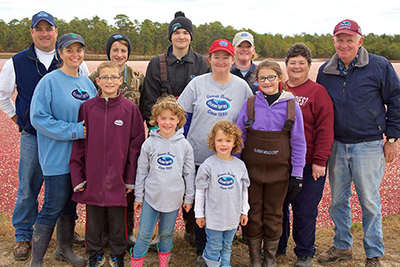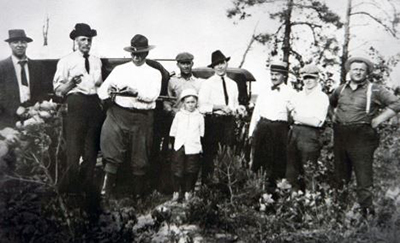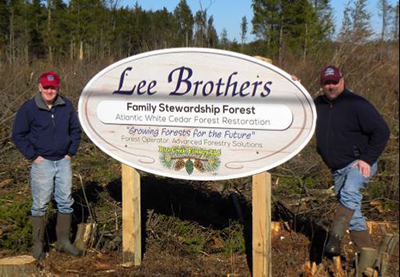 Among America’s privately owned forest lands, the Lee family property in New Jersey is a bit of a celebrity. Stephen Lee, III, owns and manages his forest land to protect the water quality for his cranberry crops, which they’ve been growing on his family’s land for well over a century. That in itself makes for an interesting story. However, his forest land has a few notable historic twists that make his tale even more remarkable and
Among America’s privately owned forest lands, the Lee family property in New Jersey is a bit of a celebrity. Stephen Lee, III, owns and manages his forest land to protect the water quality for his cranberry crops, which they’ve been growing on his family’s land for well over a century. That in itself makes for an interesting story. However, his forest land has a few notable historic twists that make his tale even more remarkable and
He owns his land in three Burlington County townships: Washington, Woodland, and Tabernacle. “It’s in the southern third of New Jersey, in an area designated as the Pinelands National Reserve in 1979 under the National Parks and Recreation Act. It was the first national reserve created in the country,” he said.
“We’re at the center of it,” he added, “about a million acres for preservation, protection, and enhancement of the resources.” About 80 percent of their roughly 2,000 acres of land is forested. Tree species there include pitch pine, shortleaf pine, oak, Atlantic white cedar, maple, gum, and others.
Lee has lived on their family land most of his life. He is accompanied there by his wife, Mary Ann; son Stephen Lee, IV, and his family; and daughter Patricia and her family. Stephen IV and Patricia are the sixth generation of Lees, and their children are the seventh generation. “Our foreman and other employees live here as well,” he said.
“My brother’s name is Abbott [Lee],” he said. “We were shareholders in the family corporation. He now runs a greenhouse operation for cranberry rooted cuttings. Today, my son and I run the forest management and cranberry production operation.” The Lee family history on their land goes way back. He said his property has been in their family since the mid-1860s.
“My great, great grandfather, Stephen Lee, bought this land from his brother-in-law and began to develop cranberry bogs. The cranberries were here along the streams. They grow naturally to the south to New Jersey and north to Massachusetts, as well as in Oregon and Wisconsin, where they’re commercially grown,” he said.
“We’ve been growing cranberries since the mid-1860s,” he added. “My great, great grandfather was an engineer, and he built dams across the streams to protect the vines in the winter. If the cranberry vine is exposed to cold air in the winter, it can dry them out and die; this submerging in water protects them.”
Cranberries are native to North America. Other native fruits include the Concord grape and the blueberry. It takes a lot of forest to protect the cranberries, Lee said. “The forest provides water quality and quantity for the cranberries. We have always protected the land surrounding our farms. The average cranberry operator in New Jersey owns 10 acres of upland, or wetland forest, for every acre of cranberries. The ratio for our farm is 135 acres of cranberries to about 1,800 acres of forest, or about 13 to 1,” he added. Since 1953, their cranberries have been marketed through Ocean Spray, a grower-owned cooperative.
Lee said his forest land serves multiple purposes. “The primary purpose of our forest land is protection of our water resource, and secondary, is some lumber. The forest land also serves as a buffer to keep people with their associated development away,” he added.
“We depend on forests for our cranberry farms to provide pure water for our cranberry operation,” he said. “The Federal drinking water standard for nitrates in the drinking water is 10 parts per million. Typically, in an area that has a lot of septic systems, the water quality will approach that number. Here in the Pinelands, our reading is 0.2 parts per million. We’ve always owned a lot of land to assure an abundant supply of that water. If the nitrates go up, that can harm our cranberry bogs.”
History & Land Management
 Their land and its owners throughout the centuries have had some significant ties to American history. “Benjamin Randolph was the original private landowner when our land was deeded by the King of England back in the early 1700s, before the American Revolution. The Society of Proprietors gave out land grants then from the king for the right to own the property,” Lee said.
Their land and its owners throughout the centuries have had some significant ties to American history. “Benjamin Randolph was the original private landowner when our land was deeded by the King of England back in the early 1700s, before the American Revolution. The Society of Proprietors gave out land grants then from the king for the right to own the property,” Lee said.
“Randolph, the owner of our land back then, had a cabinetmaking shop in Philadelphia. Some of the timber here was used to help build Philadelphia.” He added, “Benjamin’s home stood here on our land until the 1950s or so.”
“During the history of forest management of our property in the first two harvests, they were taking the very best trees for cabinetmaking, and so forth.”
Lee noted that the same Benjamin Randolph is also very famous for making the portable writing desk that Thomas Jefferson used to write the Declaration of Independence. “There’s a possibility that the wood used to make that desk came from our property. The cabinetmaker, Benjamin Randolph, was from here. In Independence Hall [in Philadelphia] he made a lot of the furniture in the Hall. He was like the Ethan Allen Furniture of that era,” he said.
The next time the woods were harvested was in the 1800s to support the iron industry, he said. The wood was used in the Speedwell Furnace on their property, first to make charcoal, and then that charcoal was used as fuel in the furnace. Unlike some owners’ split land holdings, their land is in one piece.
“It’s nearly a solid contiguous piece, except for the personal homes of our family members. There are seven homes and another six support buildings for the farm,” he added. They also have two streams, the Shoal Branch and the Main West Branch of the Wading River, that drain to the Wading River.
“Because of the confluence of the streams, Benjamin Randolph built a sawmill here,” Lee said. “We also have the remnants of the old iron furnace.” In recent years Lee uncovered some artifacts left behind the old furnace on their land.
“When we did a harvest of a portion of our land around the year 2000, we discovered a number of piles where they made charcoal. They were regularly spaced charcoal piles. It was certainly not the first time the forest had been harvested,” he said.
Forest Service Connection
Lee’s land and family even have historic ties to one of the fathers of conservation, Gifford Pinchot. Their family keeps an old black and white photograph from many years ago to remind them of the historic figure’s visit to their land. Pinchot was the first Chief of the U.S. Forest Service, from 1905-1910. He later served as the Governor of Pennsylvania from 1923-1927, and later, from 1931-1935.
“The picture does have Gifford Pinchot in it. He’s with my grandfather and my father, and others,” Lee said. “Pinchot used to come here and hunt with my grandfather. My father is the youngest person (and only child) in the photograph. My grandfather is pictured immediately behind him.”
“Conservation versus protection, that’s the battle that Pennsylvania Governor Pinchot had with that guy out west, John Muir,” he added.
“In the historical picture we have, Pinchot was here on our land as the Governor of Pennsylvania.” Another person shown in the historic photo (third from the left), dressed vaguely similar to President Theodore Roosevelt, actually was someone else – General Hugh Scott, then Chief of Staff of the Army.
“They were on a hunting trip, possibly hunting deer,” he added. “With my grandfather and father, there’s always been a strong interest in caring for the land.” “My father was Stephen Vincent Lee, Jr. I’m the third, and my son is the fourth,” said Lee.
“That photo was taken about 1918. The area where my home is today is where my grandfather raised cantaloupes.” He said they have harvested pine and Atlantic white cedar since the early 1950s for pulpwood and for 2-inch by 6-inch planks for flood control.
“We harvested, sold, and used the pine and cedar.” They used some of their harvested wood in flood control for their cranberry bogs. They would put a board in and out of a floodgate to control flooding for the bogs. “For the floodgates, we used pine. We use a 4-foot by 2-foot trunk that connects one bog with another. Many of those boards are 60 years old and still functioning. The pine, since it’s underwater, it doesn’t usually rot. The cedar is an essential component of our ongoing operation.”
Fire & Rolling Stone
For 70 years they’ve been doing controlled burning in the winter to improve forest health and reduce fire danger, he said. “About our forestry operation, we had an area that was badly burned by a forest fire around 1980, and the forest was not recovering well on its own. Beginning in 1990, we have done commercial harvesting of 600 acres to help the forest recover. In those areas we planted shortleaf pine, and a pitch/loblolly cross.”
An outing decades earlier on Lee’s land. Pictured second from the left is then Governor of Pennsylvania Gifford Pinchot. Third from the left is General Hugh Scott, Chief of Staff of the Army. Lee’s father is the child pictured in the center in the photo, and his grandfather is standing right behind him. (Photo courtesy of Stephen Lee, III)
Log trucks line the roadway during a thinning operation.
An oak/pine forest that has had prescribed burn treatment over several years.

Describing his forest management success, Lee said, “We’ve been pretty successful. We do a lot of tours here. Sometimes we’ll go to a state forestry meeting, but often the tour is here. We had a tour here of forest managers from about 20 states.” “We get lots of press coverage about the quality of our forestry. There’s a writer from Rolling Stone magazine who [was] doing a story on our forest management. His interest is on the issue of fire in the urban fringe. Our forest is surrounded by a highly urbanized area. I think active management of forests is vital to reducing fire danger to communities.” He said the Rolling Stone reporter was a smokejumper named Kyle Dickman. His book is called On the Burning Edge.
Private Landownership Advocate
“I like private land ownership,” he said. “You get better management if land is privately owned. Our neighbor is the state of New Jersey, and they’re struggling to find the resources to manage their land.” Lee said that in most states, forestry comes under an agricultural role. “We don’t have that in New Jersey; it’s under our Department of Environmental Protection.”
“This area, the Pinelands of New Jersey, is one of the most regulated land masses in the country,” he added. “It’s regulated by the New Jersey Pinelands Commission. I served on the commission for 27 years. The zoning in each town had to conform to a master plan.” He described the complexity of forest planning in the Garden State.
“Private landowners like myself have to do a forest land management plan. Yes, it is complicated. Our plan for 2,000 acres is about 150 pages long. It takes a couple years to get it approved, and it lasts for 10 years. We’re in our second 10-year cycle of having a forest management plan. As a commission member, I was one of the people responsible for adopting regulations for this area.”
“For our own farm, we began with my consulting forester Bob Williams’ help to develop a forestry management plan for our own land. We like to take a scientific approach and test different hypotheses. We have different harvesting techniques to find out what works best in the Pinelands of New Jersey. If we didn’t do that, our forests would not be of such high quality. I think we are in better shape than we would be otherwise,” he added.
Despite his regulatory challenges, Lee said he is very pleased with what they’ve been able to do to improve his forest land. He also believes private landownership is important to the success of his cranberry business. “As a cranberry grower, I think it’s essential to own land so that you can control and protect the environment for your farm. Other than the few natural resources we harvest for our own use, we don’t get a lot of revenue from our timber harvesting.”
“Forestry has not been a profit center for us,” he added, “but that’s not why we do it. If I was worried about return on investment for the next 15 years, there wouldn’t be one. It’s complicated. If we were not successful cranberry growers, we could not afford to do forest management here in New Jersey.”
“There used to be about 30 sawmills in New Jersey; today there are three. The only permitted uses for landownership in the Preservation Area of the Pinelands in this area is forestry, beekeeping, and horticulture of native plants. The native plants include blueberries, cranberries, azalea, and rhododendron. There are many things you are not permitted to do here. All those land rights have been taken away as part of the zoning. For instance, you can’t build a home here anymore. Since there are no sawmills, there’s no place to sell wood. The closest mill for us is in York, Pennsylvania, three hours west of here.”
Lee said he believes land management serves to improve forest health and resilience. “That’s why we have done and will continue to do forest management, to make the forest more resilient and less susceptible to southern pine beetle. We’re trying to maintain healthy forests. We did another 20 acres of harvesting this year to improve an Atlantic white cedar stand and about 200 acres of upland thinning since 2013. This was in a portion of the forest where the only management there had been controlled burning. We thinned the canopy there,” he added.
“We feel connected with the woods and the forest. It’s something we care about and respect and depend on in our overall agricultural operation. Forestry is a major part of our operation. We harvest a lot of cranberries, and we try to take good care of our forests. Being a steward of our forests helped me to get into better land management,” he added.
 Sign In
Sign In
 Sign In
Sign In
